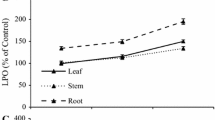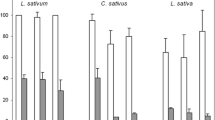Abstract
[Ring-U14C] p-hydroxybenzoic acid (POH) translocation during radish germination and early seedling growth was studied to compare two culture conditions (sterile/non-sterile) and two modes of POH extraction (ethanol/oxidizing). Quantification of POH in organs was performed by grinding them in a mortar with ethanol or by combusting them in a biological oxidizer. Comparison of these extraction methods revealed that the oxidizer provides higher POH concentrations than grinding. Uptake and translocation of POH into radish seedlings occured in the first 24 hr with the highest accumulation in cotyledons. POH in cotyledons ranged from 8 to 12.4 μmol g−1 FW. Two forms of POH were found in seedlings, an ethanol-soluble one and a “bound” one. After 96 hr incubation, half of the recovered POH was “bound” in roots and hypocotyls. POH recovery in seedlings was also higher under axenic rather than non-axenic conditions. POH was degraded into 14CO2 by microorganisms under non-sterile cultures, its concentration in culture medium decreased from 10−3 to 10−4 M between the first and the fourth day of incubation. Choice between sterile and non-sterile culture conditions as a method depends on particular research objectives. Non-sterile methods can be used to reflect natural processes whereas sterile methods can be used if the objective is to determine allelochemical penetration and biological effects on target plants.
Similar content being viewed by others
REFERENCES
BARZ, W., and WELTRING, K. M. 1985. Biodegradation of aromatic extractives of wood, pp. 607–662, in T. Higuchi (ed.). Biosynthesis and Biodegradation of Wood Components. Academic Press, San Diego, California.
BAZIRAMAKENGA, R., LEROUX, G. D., SIMRD, R. R., and NADEAU, P. 1997. Allelopathic effects of phenolic acids on nucleic acid and protein levels in soybean seedlings. Can. J. Bot. 75:445–450.
BLUM, U., AUSTIN, M. F., and SHAFER, S. R. 1999. The fates and effects of phenolic acids in a plantmicrobial-soil model system, pp. 159–166, in F. A. Macias, J. C. G. Galindo, J. M. G. Molinillo, and H. G. Cutler (eds.). Recent Advances in Allelopathy. Volume I: A Science for the Future. Servicio de Publicaciones-Universidad de Cadiz, Cadiz, Spain.
CHAO, J. F., HSIAO, A. I., QUICK, W. A., and HUME, J. A. 1994. Effect of decapitation on absorption, translocation, and phytotoxicity of imazamethabenz in wild oat (Avena sativa L.). J. Plant Growth Regul. 13:153–158.
CUADRA, P., and HARBORNE, J. B. 1996. Changes in epicuticular flavonoids and photosynthetic pigments as a plant response to UV-B radiation. Z. Naturforsch. A 51:671–680.
DALTON, B. R. 1999. The occurrence and behavior of plant phenolic acids in soil environments and their potential involvement in allelochemical interference interactions: Methological limitations in establishing conclusive proof of allelopathy, pp. 57–74, in Inderjit, K. M. M. Dakshini and L. C. Foy (eds.). Principles and Practices in Plant Ecology: Allelochemical Interactions. CRC Press, Boca Raton, Florida.
DELROT, S., and BONNEMAIN, J. L. 1991. Le transportá longue distance des herbicides dans la plante, pp. 51–77, in R. Scalla (ed.). Les herbicides: Mode d'action et principes d'utilisation. INRA, Paris, France.
DAYAN, F. E., DUKE, S. O., WEETE, J. D., and HANCOCK, H. G. 1997. Selectivity and mode of action of carfentrazone-ethyl, a novel phenyl triazolinone herbicide. Pestic. Sci. 51:65–73.
HAUGLAND, E., and BRANSAETER, L. O. 1996. Experiments on bioassay sensitivity in the study of allelopathy. J. Chem. Ecol. 22:1845–1859.
HUTZLER, P., FISCHBACH, R., HELLER, W., JUNGBLUT, T. P., REUBER, S., SCHMITZ, R., VEIT, M., WEISSENBöCK, G., and SCHNITZLER, J. P. 1998. Tissue localization of phenolic compounds in plants by confocal laser scanning microscopy. J. Exp. Bot. 49:953–965.
JOHNSON, T. A., SIMS, G. K., ELLSWORTH, T. R., and BALLANCE, A. R. 1998. Effects of moisture and sorption on bioavailability of p-hyhroxybenzoic acid to Arthrobacter sp. in soil. Microbiol. Res. 153:349–353.
KORICHEVA, J. 1999. Interpreting phenotypic variation in plant allelochemistry: Problems with the use of concentration. Oecologia 119:467–173.
MAFFEI, M., BERTEA, C. M., GARNERI, F., and SCANNERINI, S. 1999. Effect of benzoic acid hydroxy-and methoxy-ring substituents during cucumber (Cucumis sativus L.) germination. I. Isocitrate lyase and catalase activity. Plant Sci. 141:139–147.
MARTIN, J. P., and HAIDER, K. 1980. Microbial degradation and stabilization of 14C-labeled lignins, phenols, and phenolic polymers in relation to soil humus formation, pp. 77–100, in T. K. Kirk, T. Higuchi, and H. Chang (eds.). Lignin biodegradation: Microbiology, chemistry and potential applications. CRC Press, Boca Raton, Florida.
MIZUTANI, J. 1999. Plant ecochemicals which may play important roles in complex interactions between higher plants, pp. 149–158, in F. A. Macias, J. C. G. Galindo, J. M. G. Molinillo, and H. G. Cutler (eds.). Recent Advances in Allelopathy. Volume I: A Science for the Future. Servicio de Publicaciones-Universidad de Cadiz, Cadiz, Spain.
RICE, E. L. 1984. Allelopathy, 2nd ed. Academic press, New York.
SCHMUTZ, A., BUCCALA, A., JENNY, T., and RYSER, U. 1994. The phenol in the wax and in the suberin of green cotton fibres and their function. Acta Hort. 381:269–275.
SIMMEN, U. R. S., and GISI, U. 1996. Uptake and distribution in germinating wheat of [14C]SAN 789F and [14C] cyproconazole applied as seed treatment. Crop Prot. 15:275–281.
VAN SUMERE, C. F. 1989. Phenols and phenolic acids, pp. 29–73, in P. M. Dey and J. B. Harborne (eds.). Methods in Plant Biochemistry, Vol. 1: Plant Phenolics. Academic Press, New York.
Author information
Authors and Affiliations
Rights and permissions
About this article
Cite this article
Chiapusio, G., Pellissier, F. Methodological Setup to Study Allelochemical Translocation in Radish Seedlings. J Chem Ecol 27, 1701–1712 (2001). https://doi.org/10.1023/A:1010474711970
Issue Date:
DOI: https://doi.org/10.1023/A:1010474711970




